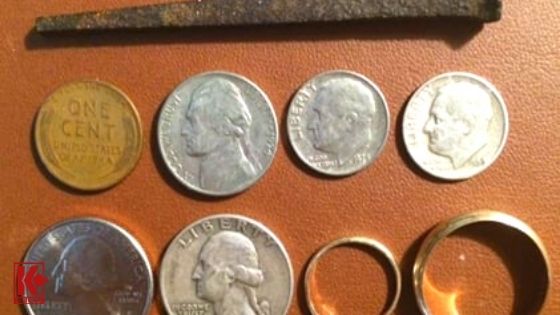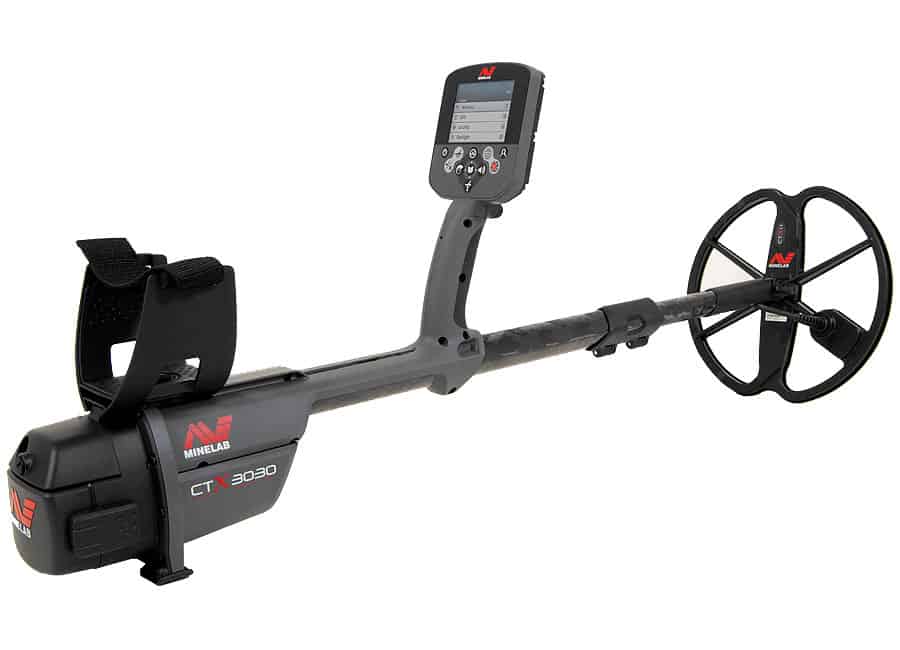Field Test: Coiltek 5×10″ on Minelab CTX-3030 Review
Published by Colonel Dan on 07/30/19
Purpose : Test the operational capability and sensitivity at depth in soil, as well as its ability to discriminate and separate good targets from iron.
Procedure : All tests conducted, observations and comments reported are from the standpoint of the first time average user and not that of a professional design engineer.
The Coiltek 5×10″ coil was mounted on the Minelab CTX-3030 to determine sensitivity, discrimination/separation and stability. Sensitivity was determined by reporting the greatest depth at which targets of various size and metallurgical composition could be reliably detected.
Discrimination/Separation : Conducted on dry land, an iron nail was moved incrementally closer to the target in both horizontal and vertical positions relative to direction of the sweep so as to determine the closest distance wherein the detector could distinguish between the iron nail and the good target.
CTX-3030 Settings : I began each round of tests using Open screen, Deep on, Fast off, Seawater on, Ferrous Coin and Sensitivity manual 25. Throughout the test, I alternated between Ferrous Coin and High Trash but could see little if any difference in coil performance under my test conditions. I also compared the results with Fast on vs Fast off (see table below).

Iron Nail , Copper Penny, Modern Nickel, Clad Dime, Silver Dime, Clad Quarter, Silver Quarter, 10K Pinky Ring, 14K Wedding Band
The targets used are as shown.
- *Iron Nail
- *Copper Penny
- *Modern Nickel
- *Clad Dime
- *Silver Dime
- *Clad Quarter
- *Silver Quarter
- *10K Pinky Ring
- *14K Wedding Band
Findings : Numerical results with observations and concluding comments are reported directly below. As with any equipment undergoing field testing, the results reflect and are dependent upon the specific test environment, targets and mineralization of the soil. Results of similar tests conducted under different conditions can be expected to differ.
Observations : The Coiltek 5×10″ was designed to provide good target discrimination and separation in moderate to high trash areas…and it does! My testing scenarios were designed to evaluate its ability to identify the good target when positioned next to the most common form of trash found on land—iron. When testing sensitivity at depth using various targets at various depths as shown on the table below, this small 5×10″ coil gave solid hits on good targets at a maximum depth of between 6-8 inches. The Ferrous Coin setting seemed to perform the best but with little difference when switching to the High Trash mode.
In terms of sensitivity at depth, I was impressed by the coils ability to detect targets at the reported depths…and it did so solidly (see table below). With Deep on and Fast off the CTX was able to hit on targets approximately 0.5 to 1.5 inches deeper than with the settings of Deep off and Fast on. However, the trade off became clear when testing for discrimination and separation. With Deep off and Fast on, I was able to detect the targets at significantly closer distances to the iron nail than with the Fast off setting (see table below). In fact, I was able to successfully detect good targets when the iron nail was vertical/perpendicular to the direction of sweep and placed directly on top of and touching the good target. Note: A significantly slower sweep speed was necessary when the good target was within 1-2 inches of the nail with the nail laying in a horizontal/parallel posture relative to the sweep direction. Too fast of a sweep speed could and in some cases did result in detection latency or a total masking of the good target.
I then took the CTX with the Coiltek 5×10″ over land containing what I knew to be a variety of targets. The CTX ran very smoothly throughout the full range of test scenarios and produced solid hard hitting tones. Areas with greater amounts of trash, required a much slower sweep speed in order to detect/separate the good targets from the trash.
| Sensitivity at Depth | |
|---|---|
| Values = inches | |
| Copper Penny | 6 |
| Modern Nickel | 7 |
| Clad Dime | 6 |
| Silver Dime | 6 |
| Clad Quarter | 7 |
| Silver Quarter | 8 |
| 10K Ring | 6 |
| 14K Ring | 8 |
Settings : Coil stable and solid tones in both test scenarios – Depth and Separation
Open Screen; Deep On; Fast Off; Seawater On; Ferrous Coin
| Separation | H Foff | H Fon | V |
|---|---|---|---|
| Values = inches | |||
| Copper Penny | 3 | 2 | 0 |
| Modern Nickel | 4 | 2 | 0 |
| Clad Dime | 3 | 1 | 0 |
| Silver Dime | 3 | 1 | 0 |
| Clad Quarter | 1 | 1 | 0 |
| Silver Quarter | 1 | 1 | 0 |
| 10K Ring | 3 | 1.5 | 0 |
| 14K Ring | 1 | 1 | 0 |
Closest distance with distinguishable separation between nail and good target.
Nail orientation relative to the direction of the coil sweep :
- * H=Horizontal (parallel) V=Vertical (perpendicular)
- * 0 = Good target detected with nail on top
- * X = Good target not detected; Completely masked
H Foff = Fast Off; H Fon= Fast On
Very slow sweep speed required to have successful target separation when target approached 1″ distance from iron nail.
Settings : Same as Depth test with exception of Fast on/off selection.
Conclusions : Overall I was impressed with this coil in terms of sensitivity, discrimination, separation and stability. The operation was solidly stable with no chatter or falsing even when the coil was bumped against the ground. It was sensitive to smaller targets and it’s ability to separate the good from the bad was exceptional when the CTX was set with Fast on and the sweep speed was maintained at a slower pace. I very much liked the solid face design which prevented weeds, sticks and other vegetation and debris from tangling in the coil as sometimes occurs with open face coils. The Coiltek glided smoothly over all forms of terrain—grass, weeds, sticks and soil. Although it did appear to be slightly heavier than some other coils in the same category, it was well within my comfort zone.
Bottom Line : This little 5×10″ coil gave a very good accounting of itself and worked like a champ. I can confidently say the Coiltek 5×10″ will successfully serve those detecting in underbrush or areas strewn with trash. It can separate with the best and do so at respectable depths on a variety of target types.
Minelab CTX-3030
This is Minelab’s highest performing all-around metal detector. It can find objects in every type of soil, including mineralized ground where gold is found. This machine has five preset search modes and is also fully customizable for more advanced detectorists. This detector works in any terrain, including the ocean and wet beach sand.
Our customers say that this detector is heavy but well-balanced. If you plan on using this for an extended period of time, a harness is available to help relieve some of the strain.
- Weight: 5.20 pounds
- Frequency: 1.5 kHz – 100 kHz
- Waterproof: Up to 10 feet
- Warranty: Three-year limited

- Programmable to fit your needs
- Most accurate target identification on the market
- GPS to track your finds
- It is heavy — over 5 pounds
- Higher price point
- Slower processor than newer detectors on the market
- “I had the pleasure of calling and talking to Kellyco … looking to upgrade... I was looking for the best land and best water machine. Your rep explained all of the differences and highly recommended the CTX-3030. One machine for both. Why buy two different machines when one detector does both? It has been the best buy I have ever made. It took a little bit to get used to the sounds but I have absolutely no regrets. Great for the days that I want to hunt both land and water. Thank you very much for the recommendation.” - Paul
